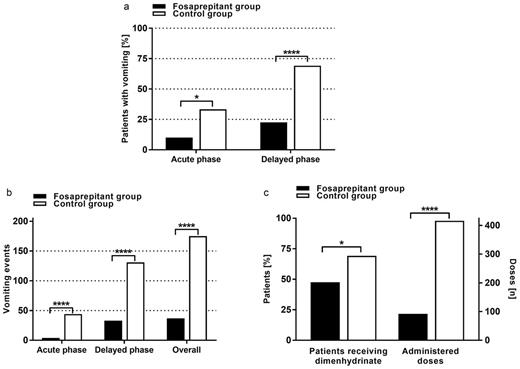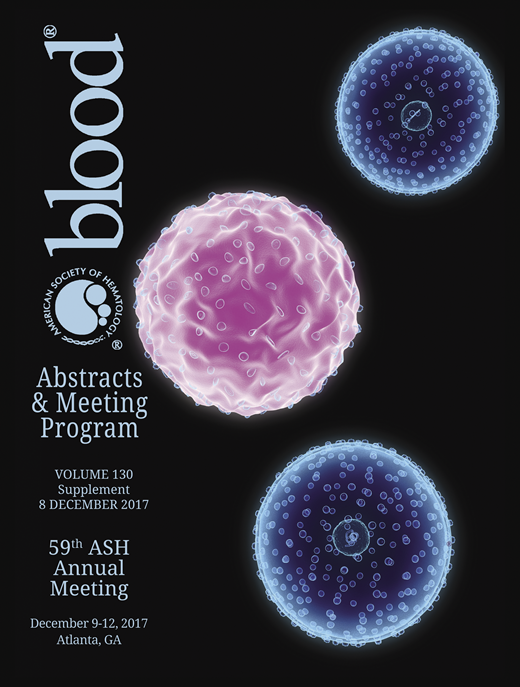Abstract
Introduction
Chemotherapy induced nausea and vomiting (CINV) belongs to the most feared and burdensome side effects and poses a substantial impairment of the quality of life, especially in pediatric patients. In adults, antiemetic prophylaxis with a combination of ondansetron, corticosteroids and aprepitant has shown favorable results as compared to ondansetron and corticosteroids alone. Valuable data on aprepitant or its water-soluble derivative fosaprepitant is scarce for pediatric patients.
Patients and Methods
This retrospective single-center analysis enrolled 79 pediatric patients with a median age of 8 years (range 0.8 - 18 years) who received either fosaprepitant (3.5 - 4 mg per kg bodyweight (maximum 150 mg))/ondansetron combination prophylaxis (n=40; fosaprepitant group, 112 chemotherapy cycles analyzed), or ondansetron only (n=39; control group, 116 chemotherapy cycles analyzed). Antiemesis was performed according to the current antiemesis guidelines (NCCN Clinical Practice guidelines in Oncology): Intravenous Ondansetron was started at least 30 minutes prior to start of chemotherapy and administered throughout the chemotherapy cycle (bodyweight adapted; max. 32 mg per 24 hours). Fosaprepitant single-dose administration was started at least one hour before the first application of chemotherapy at a dosage of 3.5 - 4 mg per kg bodyweight (maximum 150 mg) as intravenous infusion within 30 minutes. The groups were comparatively analyzed for occurrence and frequency of vomiting, additional need for dimenhydrinate medication and drug-related clinical (exanthema, sweating, fever, loss of appetite, diarrhea and constipation) and laboratory (increases of ALT, AST, bilirubin, creatinine, urea; decreases of calcium, potassium, sodium) side effects during the acute (<24h) and delayed (>24h) CINV phases of moderate (CINV risk 30%-59%) and high (CINV risk ≥60%) emetogenic chemotherapy. Exclusion criteria were vomiting or administration of antiemetic medication until 48 hours prior to the start of emetogenic chemotherapy, and chemotherapy with ifosfamide.
Results
In the acute CINV phase, the number of patients experiencing vomiting (33.3% of the patients; Fig. a) and the total number of vomiting events (n=44; Fig. b) was significantly higher (p=0.02449 and p<0.0001, respectively) in the control group when compared to the fosaprepitant group (10.0% of the patients, n=4 events). Even more pronounced were the results for the delayed CINV phase with a significantly higher (p<0.0001) number of patients experiencing vomiting (69.2% vs. 22.5%) and a significantly higher (p<0.0001) number of vomiting events (n=131 vs. n=33 events). The number of patients needing additional medication with dimenhydrinate and more importantly the total number of administered dimenhydrinate doses was significantly higher in the control group (69.2% vs. 47.5% of the patients, p=0.04884; n=416 vs. n=92 doses, p<0.0001) (Fig. c). Differences of all clinical side effects and changes of laboratory parameters were not significantly different between both study groups.
Conclusion
Taken together, our findings are consistent with previous randomized trials with adult hemato-oncological patients and a retrospective chart analysis with pediatric patients in terms of safety, efficacy and feasibility of fosaprepitant as antiemetic prophylaxis during moderate and high emetogenic chemotherapy (Grunberg et al., 2011, Saito et al., 2013, Okumura et al., 2017, Shillingburg and Biondo, 2014). This is the first available data on the administration of single dose intravenous fosaprepitant in pediatric patients under the age of 12 years. In comparison to antiemesis with ondansetron only, a combination prophylaxis with fosaprepitant proved to be clearly superior with fewer pediatric patients experiencing vomiting, distinctly fewer vomiting events in the acute (11.0 -fold) and delayed (4-fold) CINV phase and an overall 4.5-fold reduction of administered dimenhydrinate doses. However, larger randomized prospective trials with pediatric patients are needed to evaluate our findings.
No relevant conflicts of interest to declare.
Author notes
Asterisk with author names denotes non-ASH members.


